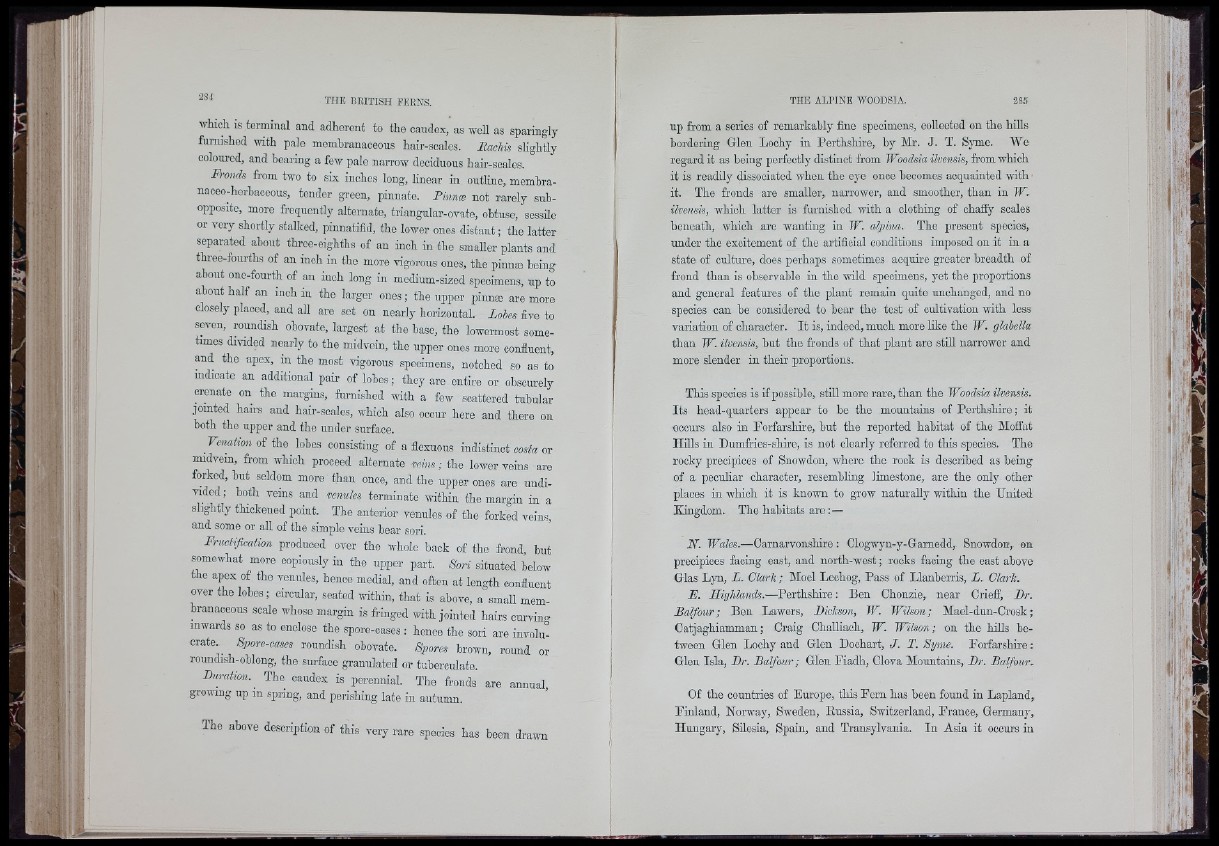
;ììì:;J? (
which is terminal and adherent to tho oaudox, as well as sparingly
furnished with palo momhranaoeous hair-soales. EacMs slig h t ly
coloured, and bearing a few palo narrow deciduous hair-scales.
Fronds from two to six inches long, linear in outline, membra-
naooo-horbaooous, tender green, pinnate. Pinna} not rarely sub-
opposite, more frequently altemato, triangular-ovate, obtuse, sessile
or very shortly stalked, pinnatifid, tho lower ones distant ; the latter
separated about three-eighths of an inch in the smaller plants and
three-fourths of an inch in the more vigorous ones, the pinnæ being
about one-foiirth of an inch long in medium-sized specimens, np to
about half an inch in tho larger ones ; the upper pinnæ are more
closely placed, and all are set on nearly horizontal. Lohes five to
seven, roundish obovate, largest at the base, tho lowermost sometimes
divided nearly to the midvcin, the upper ones more confluent,
and the apex, in the most vigorous specimens, notched so as to
indicate an additional pair of lobes; they aro entire or obscurely
crenato on the margins, famished with a few scattered tubular
jointed hairs and hair-soales, which also occur here and there on
both the upper and the under surface.
Venation o î i \ e lobes consisting of a floxuous indistinct cosfe or
midvein, from which proceed alternate veins; the lower veins aro
forked, but seldom more than once, aud the upper ones are undi-
wded ; both veins and venules terminate within the margin in a
slightly thickened point. The anterior venules of the forked voins,
and some or aU of the simple veins hear sori.
Fructifleation produced over the whole back of the frond, but
somewhat more copiously in the upper part. Bori situated below
the apex of the venules, hence medial, and often at length confluent
over the lohes; circular, seated within, that is above, a small membranaceous
scale whose margin is fringed with jointed hairs curring
inwards so as to enclose the spore-cases : hence the sori are involúcrate.^
Spore-cases roundish obovate. Spores brown, round or
roundish-oblong, the sui-face granulated or tiiberculate.
Buration. The caudex is perennial. The fronds are annual
growing up in spring, and perishing late in autumn.
The above description of this very rare species has been drawn
up from a series of remarkably fine specimens, collected on the hiUs
bordering Glen Looby in Perthshire, hy Mr. J. T. Syme. We
regard it as being perfectly distmot from Woodsia ilvensis, from which
it is readily dissociated when the eye once beoomcs acquaintod with
it. The fronds are smaller, narrower, and smoother, than in W.
ilvensis, which latter is furnished with a clothing of ohafiy scales
beneath, which aro wanting in W. alpina. The present species,
under the excitement of the artificial conditions imposed on it in a
state of culture, does perhaps sometimes acquire greater breadth of
frond than is observable in the wild specimens, yet the proportions
and general features of the plant remain quite unchanged, and no
species can bo considered to bear the test of cultivation with less
variation of character. It is, indeed, much more hire tho W. glabella
than W. ilvensis, but the fronds of that plant are stiU narrower and
more slender iu their proportions.
This species is if possible, stiU more rare, than the Woodsia ilve'
Its head-quarters appear to be the mountains of Perthshire; it
occurs also in Forfarshfre, hut the reported habitat of the Moffat
Ilills in Dumfries-shire, is not clearly referred to this species. The
rooky precipices of Snowdon, where the rook is described as being
of a peculiar character, resembling limestone, are the only other
places in which it is known to grow naturally within tho United
Kingdom. The habitats are:—
N. Wales.—Carnarvonshire : Clogwyn-y-Garnedd, Snowdon, on
precipices facing east, and north-west; rooks facing the east above
Glas Lyn, L. Clark; Moel Leohog, Pass of Llanberris, L. Clark.
E. Highlands.—Perthshire: Ben Chonzie, near Crieff, Br.
Balfour; Ben Lawers, Bickson, W. Wilson; Mael-dun-Crosk;
Catjaghiamman; Craig ChaUiaoh, W. Wilson; on the hiUs between
Glen Lochy and Glen Doohart, J. T. Syme. Forfarshfre:
Glen Isla, Br. Balfour; Glen Fiadh, Clova Mountains, Br. Balfour.
Of the countries of Europe, this Fern has been foimd in Lapland,
Finland, Norway, Sweden, Eussia, Switzerland, France, Germanj',
Hungary, Silesia, Spain, and Transylvania. In Asia it occurs in
iii
I' l
A
kV'l
ÌD"|
iJI
*
r i i
' t t
ill
■Y ii
%